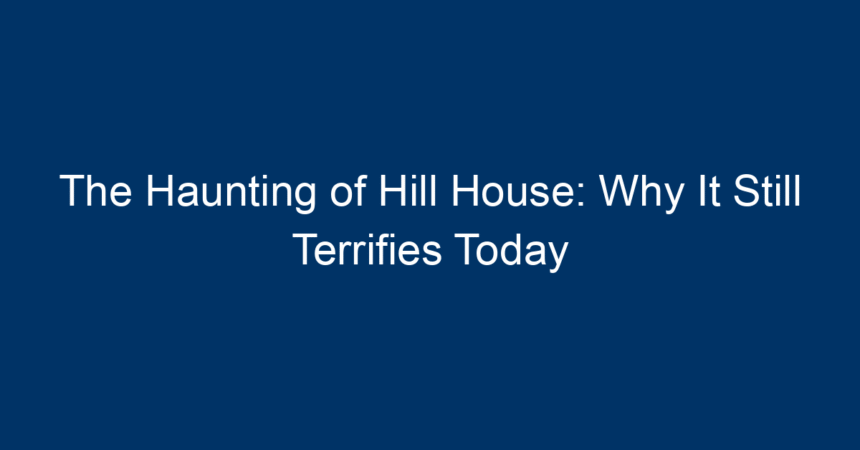Introduction
“The Haunting of Hill House” has become a cornerstone of horror literature and visual media, captivating audiences since its initial publication in 1959 by Shirley Jackson. This gothic novel, later adapted into films and a popular Netflix series, continues to elicit fear in readers and viewers alike. But what is it about this tale of psychological terror and supernatural occurrences that keeps it relevant and terrifying, even decades later? In this article, we’ll explore the haunting themes, complex characters, and unsettling atmosphere of “The Haunting of Hill House” and uncover why it remains a reference point for horror enthusiasts today.
The Mastery of Psychological Horror
The Depth of Characterization
One reason “The Haunting of Hill House” continues to terrify is its intricate character development. Shirley Jackson crafts deeply flawed characters, such as Eleanor Vance, who serves as the story’s psychological anchor. Her internal struggles and fragile mental state render her vulnerability palpable, creating an unsettling connection between the reader and the protagonist.
This mastery of character extends to other figures in the story as well. The familial tensions within the Crain family, alongside the dynamics of friendship and fear among the characters, add layers to the narrative that have psychological implications. Readers and viewers can easily identify with the characters’ fear, making the terror feel more immediate and personal.
Fear of the Unknown
At its core, “The Haunting of Hill House” embodies the quintessential fear of the unknown. Much of the horror stems from unseen entities and unexplained phenomena. Jackson skillfully employs suggestive language that invites readers to fill in the blanks, often conjuring images far more dreadful than anything explicitly described.
For instance, the house itself is as much a character as any of the residents. Its whispering walls, shifting shadows, and eerie architecture contribute to a pervasive sense of dread. This clever use of ambiguity allows readers to project their own fears onto the story, making the horror both universal and intensely personal.
Supernatural Elements and Their Disturbing Effects
The House Itself: A Character of Its Own
Hill House is an architectural enigma—a structure functioning almost as a living entity. Its unusual angles, doors that open into walls, and rooms that seem to be alive with their own energy create an atmosphere of claustrophobic dread. This disorienting setting is emblematic of the spatial horror genre, where the very environment amplifies the characters’ psychological distress.
The house’s influence on its inhabitants raises questions about the nature of evil and how much it can dictate the choices of individuals. The blending of the supernatural with psychological terror creates a potent cocktail that leaves an indelible mark on the audience.
Ghostly Apparitions and Unseen Forces
The presence of ghosts and unseen forces in “The Haunting of Hill House” serves as a literary device that questions the boundary between reality and the supernatural. The moments when characters interact with apparitions are laden with significance, often revealing deeper truths about their own psyches.
For example, the haunting of Eleanor reflects her inner turmoil and desire for belonging, making the interactions more than mere frights. This layered approach to the supernatural ensures that even those who may not believe in ghosts can appreciate the psychological implications of terror.
Themes That Resonate
Family Dynamics and Trauma
A significant theme in “The Haunting of Hill House” is the exploration of family trauma. The Crain family’s dark history adds a profound layer to the narrative, illustrating how unresolved issues can seep into the psyche. The characters are haunted not just by the ghosts in Hill House but by their collective past, a theme that resonates with many families today.
This focus on generational trauma makes the story feel contemporary, even to modern audiences. The characters’ struggles to escape their familial ties mirror real-life dilemmas, creating a haunting reflection of our own lives.
Isolation and Loneliness
Another theme that amplifies the terror in “The Haunting of Hill House” is isolation. As the characters confront their fears within the confines of the house, the walls close in, evoking feelings of suffocation and dread. This isolation magnifies their personal fears and insecurities, making the horror feel more immediate and relatable.
The emotional weight of loneliness is palpable in Eleanor’s quest for connection, which only becomes more poignant as she grapples with the house’s influence. Readers and viewers can empathize with Eleanor’s longing for belonging, intensifying her terrifying experiences.
Modern Adaptations and Legacy
The Netflix Series: A New Take on a Classic
In 2018, Netflix released a highly acclaimed adaptation of “The Haunting of Hill House,” bringing the story to a new generation. While the series diverges in some aspects from the original novel, it captures the spirit of Jackson’s work, emphasizing the family dynamics and psychological horror.
The series intertwines horror with heartfelt moments, delving into the characters’ backstories and their lasting effects on each other. By exploring past traumas and intergenerational relationships, the show expands upon the thematic elements that make the original work so enduring.
The Ongoing Influence of Shirley Jackson
Shirley Jackson’s work has paved the way for countless horror writers and filmmakers, influencing the genre in profound ways. Her ability to blend psychological nuances with supernatural elements can be seen in various forms of media today, from literature to television and film. This ongoing legacy reinforces how “The Haunting of Hill House” is not merely a story of ghosts, but a deep exploration of human emotion, fear, and the unknown.
Actionable Insights for Today’s Horror Writers and Fans
Embrace Psychological Depth
For aspiring horror writers, the lesson from “The Haunting of Hill House” is clear: focus on psychological depth. Characters with rich inner lives and emotional struggles resonate more deeply with readers. The horror becomes more impactful when the readers can see themselves in the characters.
Crafting Ambiguity
Ambiguity is powerful in horror. Consider how much fear can come from what isn’t shown. Leaving some elements open to interpretation invites readers and viewers to project their own fears, thereby enhancing the terror.
Study the Classics
For fans and creators alike, revisiting classics like “The Haunting of Hill House” reveals timeless lessons about fear and human experiences. Understanding these foundational texts can deepen appreciation for modern horror and inspire fresh interpretations.
Conclusion
“The Haunting of Hill House” remains a towering figure in horror literature and adaptation because of its intricate character development, unsettling atmosphere, and exploration of timeless themes. The psychological depth and ambiguity woven into the narrative resonate with audiences, making it an enduring reference point for fear.
As we grapple with our own fears and the haunting specters of familial trauma and isolation, this story will undoubtedly continue to terrify and fascinate for generations to come. Whether you’re reading the original novel or watching one of its adaptations, “The Haunting of Hill House” offers a chilling journey that echoes long after the last page is turned or the final scene plays out.




